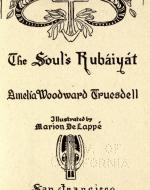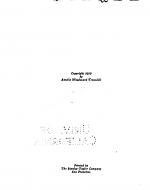Created by Jillian Altimus on Wed, 05/24/2023 - 12:55
Description:
Overall, the information about the publisher is not widely available on the internet and it's challenging to find a concrete timeline of A.M. Robertson. The only resource about the publisher is a non-digitized collection in the UC Berkley Library with photographs and articles detailing the start of A.M. Robertson's business.
As previously documented in other exhibits, the history of The Soul’s Rubáiyát is not widely available through internet sources such as Wikipedia or other online search databases. Marion De Lappé’s work is hard to locate in other archives or museums. The poem was published by AM Robertson in 1911 (see figure 2) and the book was printed by The Stanley-Taylor Company, also located in San Francisco (see figure 3).
The printing company was involved in a California Supreme Court titled, “Stanely-Taylor Co v. Board of Supervisors” in 1902. The dispute was around contracts and negotiations, and the ending result of the case was that the courts sided with the supervisors. The case text states that the California Supreme Court made this decision based on it serving the public’s interest. This case is one of the only surviving records of the Stanley-Taylor Company that demonstrates how the state creates and drives the contents of an archive. Overall, the lack of information about the printing company suggests that the company either went bankrupt or merged with another printing company.
A.M. Robertson’s public history is in academic libraries and online archives. It was founded by Alexander Mitchell in the late 1800s in California. According to the Internet Archive’s Open Library, they began to publish books in 1898. Some of their books can be found at the Oregon State University Valley Library; they published titles such as Stanford Stories: Tales of a Young University and Idyls of El Dorado. In addition, a collection of books published by A.M. Robertson can be found at the UC Berkeley Bancroft Library. In the end, A.M. Robertson did not survive -- according to the Harry Ransom Center at The University of Texas at Austin, the publishing company is a “firm out of business.” A.M. Robertson went out of business in 1931, most likely due to the Great Depression.
The art in the book has Orientalist aspects (see figure 1 ). The drawings have no annotations, only listing Marion De Lappé as the illustrator. The lack of information about the drawings makes the book look like a cultural commodity. A majority of readers at the time would probably not have questioned the inclusion or would have been inclined to research and try and figure out who was being pictured. These illustrations could have also been added to try to increase sales of the book and consumers would have been less likely to buy a book that did not have any art. The original intention could have been admiration or trying to enhance the text, but there is no way to confirm it.
WORKS CITED:
https://norman.hrc.utexas.edu/Watch/fob_search_results_next.cfm?FOBFirmN...
https://oac.cdlib.org/search?style=oac4;Institution=UC%20Berkeley::Bancr...
https://openlibrary.org/publishers/A.M._Robertson
https://casetext.com/case/stanley-taylor-co-v-supervisors
http://www.books-about-california.com/Pages/A_M_Robertson_Publisher.html




